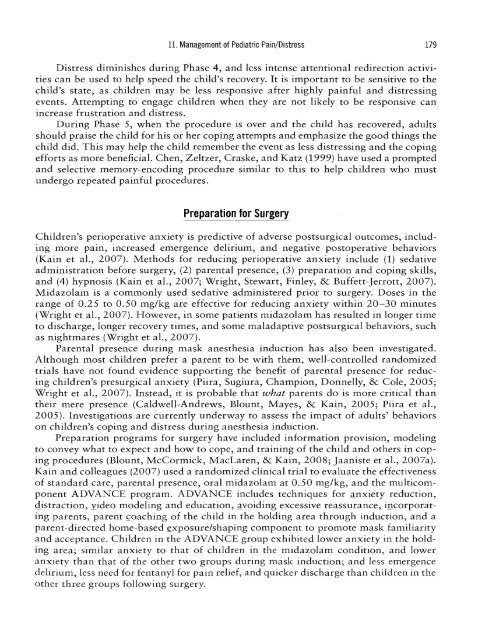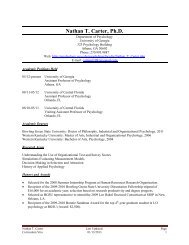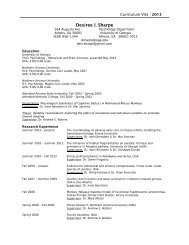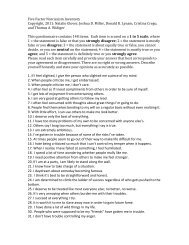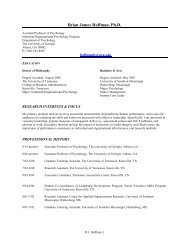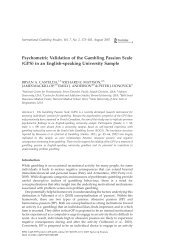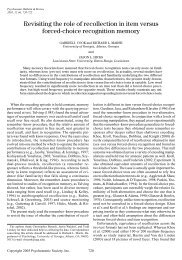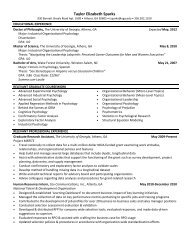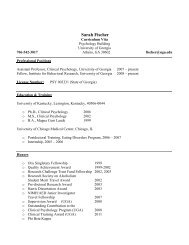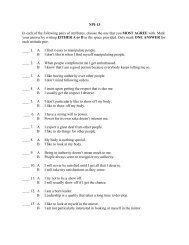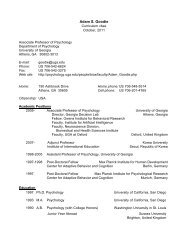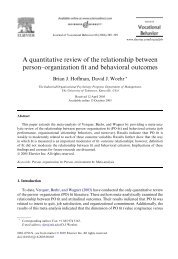Management of Pediatric Pain and Distress Due to Medical ...
Management of Pediatric Pain and Distress Due to Medical ...
Management of Pediatric Pain and Distress Due to Medical ...
Create successful ePaper yourself
Turn your PDF publications into a flip-book with our unique Google optimized e-Paper software.
11. <strong>Management</strong> <strong>of</strong> <strong>Pediatric</strong> <strong>Pain</strong>/<strong>Distress</strong>179<strong>Distress</strong> diminishes during Phase 4, <strong>and</strong> less intense attentional redirection activitiescan be used <strong>to</strong> help speed the child's recovery. It is important <strong>to</strong> be sensitive <strong>to</strong> thechild's state, as children may be less responsive after highly painful <strong>and</strong> distressingevents. Attempting <strong>to</strong> engage children when they are not likely <strong>to</strong> be responsive canincrease frustration <strong>and</strong> distress.During Phase 5, when the procedure is over <strong>and</strong> the child has recovered, adultsshould praise the child for his or her coping attempts <strong>and</strong> en1.phasize the good things thechild did. This may help the child remember the event as less distressing <strong>and</strong> the copingefforts as more beneficial. Chen, Zeltzer, Craske, <strong>and</strong> Katz (1999) have used a prompted<strong>and</strong> selective memory-encoding procedure similar <strong>to</strong> this <strong>to</strong> help children who mustundergo repeated painful procedures.Preparation for SurgeryChildren's perioperative anxiety is predictive <strong>of</strong> adverse postsurgical outcomes, includingmore pain, increased emergence delirium, <strong>and</strong> negative pos<strong>to</strong>perative behaviors(Kain et aI., 2007). Methods for reducing perioperative anxiety include (1) sedativeadministration before surgery, (2) parental presence, (3) preparation <strong>and</strong> coping skills,<strong>and</strong> (4) hypnosis (Kain et aI., 2007; Wright, Stewart, Finley, & Buffett-]errott, 2007).Midazolam is a commonly used sedative administered prior <strong>to</strong> surgery. Doses in therange <strong>of</strong> 0.25 <strong>to</strong> 0.50 mg/kg are effective for reducing anxiety within 20-30 minutes(Wright et aI., 2007). However, in some patients midazolam has resulted in longer time<strong>to</strong> discharge, longer recovery times, <strong>and</strong> some maladaptive postsurgical behaviors, suchas nightmares (Wright et aI., 2007).Parental presence during mask anesthesia induction has also been investigated.Although most children prefer a parent <strong>to</strong> be with them, well-controlled r<strong>and</strong>omizedtrials have not found evidence supporting the benefit <strong>of</strong> parental presence for reducingchildren's presurgical anxiety (Piira, Sugiura, Champion, Donnelly, & Cole, 2005;Wright et aI., 2007). Instead, it is probable that what parents do is more critical thantheir mere presence (Caldwell-Andrews, Blount, Mayes, & Kain, 2005; Piira et aI.,2005). Investigations are currently underway <strong>to</strong> assess the impact <strong>of</strong> adults' behaviorson children's coping <strong>and</strong> distress during anesthesia induction.Preparation programs for surgery have included information provision, modeling<strong>to</strong> convey what <strong>to</strong> expect <strong>and</strong> how <strong>to</strong> cope, <strong>and</strong> training <strong>of</strong> the child <strong>and</strong> others in copingprocedures (Blount, McCormick, MacLaren, & Kain, 2008; ]aaniste et aI., 2007a).Kain <strong>and</strong> colleagues (2007) used a r<strong>and</strong>omized clinical trial <strong>to</strong> evaluate the effectiveness<strong>of</strong> st<strong>and</strong>ard care, parental presence, oral midazolam at 0.50 mg/kg, <strong>and</strong> the multicomponentADVANCE program. ADVANCE includes techniques for Q.nxiety reduction,distraction, yideo modeling <strong>and</strong> education, Qvoiding excessive reassurance, incorporatingparents, parent ~oaching <strong>of</strong> the child in the holding area through induction, <strong>and</strong> aparent-directed home-based ~xposure/shapingcomponent <strong>to</strong> promote mask familiarity<strong>and</strong> acceptance. Children in the ADVANCE group exhibited lower anxiety in the holdingarea; similar anxiety <strong>to</strong> that <strong>of</strong> children in the midazolam condition, <strong>and</strong> loweranxiety than that <strong>of</strong> the other two groups during mask induction; <strong>and</strong> less emergencedelirium, less need for fentanyl for pain relief, <strong>and</strong> quicker discharge than children in theother three groups following surgery.


